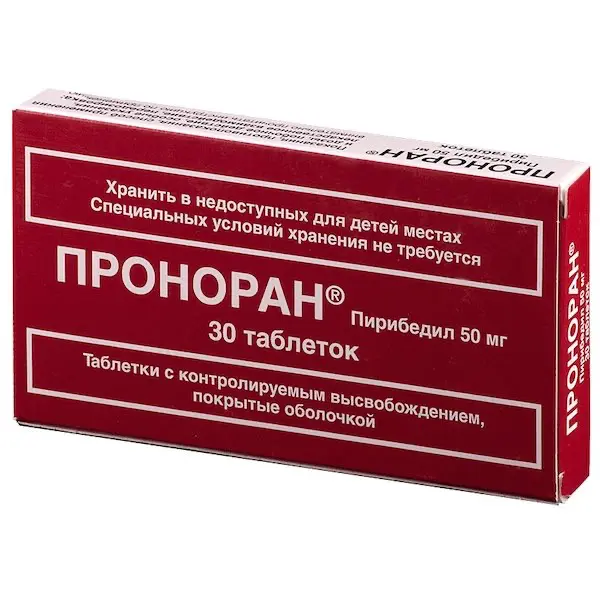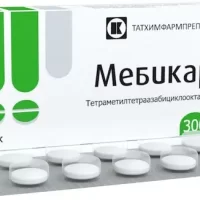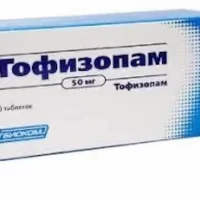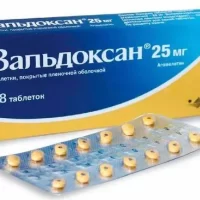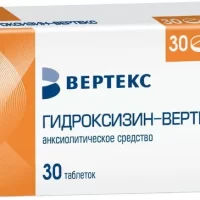Description
Pronoran Pharmacodynamics
The active ingredient pyribedil is a dopaminergic receptor agonist. It penetrates into cerebral bloodstream, where it binds to dopaminergic receptors in the brain, showing high affinity and selectivity towards D2 and D3 dopaminergic receptors. Piribedil mechanism of action determines the main clinical properties of the drug for treatment of Parkinson’s disease both in initial and later stages of the disease with influence on all basic motor symptoms. Piribedil, in addition to its effect on dopaminergic receptors, is an antagonist of two major central nervous system (CNS) alpha-adrenergic receptors (a2A and a2C types).
The synergistic effects of pyribedil as both an a2 receptor antagonist and a dopaminergic brain receptor agonist have been demonstrated in various animal models with Parkinson’s disease: long-term use of pyribedil results in less severe dyskinesia than the use of levodopa, with similar efficacy against the reversible akinesia associated with Parkinson’s disease.
Pharmacodynamic studies in humans have shown excitation of cortical dopaminergic electrogenesis both on awakening and during sleep with demonstration of clinical activity in relation to various dopamine-controlled functions, this activity has been demonstrated using a behavioral or psychometric scale. Pyribedil has been shown to improve attention and alertness related to cognitive tasks in healthy volunteers.
The effectiveness of Pronoran as monotherapy or in combination with levodopa in the treatment of Parkinson’s disease has been studied in three double-blind, placebo-controlled clinical trials (2 studies compared to placebo and one compared to bromocriptine). The studies enrolled 1103 patients with stage 1-3 Hoehn & Jahr, 543 of whom received Pronoran.
Pronoran at a dose of 150-300 mg/day has been shown to be effective in acting on all motor symptoms with 30% improvement on the Uniform Parkinson’s Disease Rating Scale (UPDRS) Part III (motor) over 7 months with monotherapy and 12 months in combination with levodopa. Improvement in the “activities of daily living” part of the UPDRS II scale was rated at the same values.
In monotherapy, the statistically significant proportion of patients needing emergency levodopa treatment receiving piribedil (16.6%) was lower than in the group of patients receiving placebo (40.2%).
The presence of dopaminergic receptors in the vessels of the lower extremities explains the vasodilatory effect of piribedil (it increases blood flow in the vessels of the lower extremities).
Indications
– Auxiliary symptomatic therapy in chronic cognitive impairment and neurosensory deficits in aging (attention deficits, memory deficits, etc.)
– Parkinson’s disease
– monotherapy (for forms that predominantly involve tremor)
– as part of combined therapy with levodopa, both in the initial and later stages of the disease, especially in forms that include tremor;
– As adjunctive symptomatic therapy in intermittent claudication due to lower limb arterial obliterative disease (Leriche and Fontaine stage 2);
– Therapy for symptoms of ophthalmic diseases of ischemic genesis (decreased visual acuity, narrowed field of view, decreased color contrast, etc.).
Contraindications .
– Hypersensitivity to pyribedil and/or excipients that are part of the drug.
– Collapse.
– Acute stage of myocardial infarction.
– Concomitant use with neuroleptics (except clozapine) (see section “Interaction with other medicinal products”).
– Childhood under 18 years of age (due to lack of data).
Caution:
Due to the fact that the drug contains sucrose, patients with intolerance to fructose, glucose or galactose, as well as patients with sucrose isomaltase deficiency (a rare metabolic disorder) are not recommended to take the drug.
How to use and dosages.
- Inside. Tablet should be taken after a meal with half a glass of water, without chewing.
- For all indications, except Parkinson’s disease? 50 mg (1 tablet) once a day. In more severe cases: 50 mg twice daily.
- Parkinson’s disease:
- – Monotherapy: 150 to 250 mg (3 to 5 tablets) per day, divided into 3 doses per day. If it is necessary to take the drug in a dose of 250 mg, it is recommended to take 2 tablets of 50 mg in the morning and afternoon and one tablet in the evening.
- – in combination with levodopa drugs: 150 mg (3 tablets) per day, it is recommended to divide into 3 doses.
- When adjusting the dose, if increasing, it is recommended that the dose be titrated, gradually increasing by one tablet (50 mg) every two weeks.
- Cessation of Treatment.
- Abrupt discontinuation of therapy with a dopaminergic receptor agonist is associated with the risk of malignant neuroleptic syndrome. To avoid this, the piribedil dose should be reduced gradually until complete withdrawal.
- Habit and craving disorders.
- The lowest effective dose of the drug should be prescribed to avoid the risk of habit and craving disorders. If such symptoms occur, it is necessary to consider reducing the dose or gradually discontinuing therapy with the drug (see section “Special indications”).
- Patients with hepatic and/or renal insufficiency.
- Studies of pyribedil use in this group of patients have not been conducted. Piribedil should be used with caution in patients with hepatic and/or renal failure.
- Children and adolescents.
- Efficacy and safety of pyribedil use in children and adolescents under 18 years old has not been studied, and currently there are no data on the use of pyribedil in this population. There are no reasonable indications for the use of pyribedil in the pediatric population.

